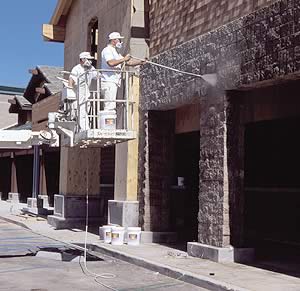
Sealing Masonry
Knowing the difference between waterproofers and sealers can help contractors and consumers avoid the nasty nuisance of water, water everywhere.
by Jeff Woodard
are often used interchangeably, but are they really the same thing?
For treating concrete brick, clay bricks and cement-based bricks, the answer is simple: No. And knowing the difference between the two can help contractors and consumers avoid the nasty nuisance of “water, water everywhere.”
Waterproofers — generally made from rubber, plastic or a sealing agent — keep moisture both in and out. “A waterproofer penetrates the pores of the masonry and expands as it dries to become a part of the masonry,” says Michele Margotta Neary, public relations director for United Gilsonite Laboratories (UGL) in Scranton, Pa. “[It] creates a continuous film.”
A water sealer, on the other hand, is a repellent designed to cause water to bead up on a surface while allowing moisture vapor to pass through. “Sealers are typically applied in such a way as to flood the substrate,” says Bill Rafie, director of marketing, commercial segments, for The Sherwin-Williams Company in Cleveland, Ohio. “This ensures that the substrate — which is usually very porous — is sufficiently covered.” Water sealers can be applied with a brush, roller or sprayer. Only one coat is recommended unless the surface is extremely porous.
The notion of a drop of water wreaking havoc on masonry brick or stone may sound strange. “But constant exposure to water — and especially to winter’s freeze/thaw cycles — can damage or destroy masonry surfaces in a surprisingly short amount of time,” says Neary.
For an above-grade brick or masonry surface exposed to wind-driven rain or other weather elements (but not subjected to hydrostatic pressure), a water sealer fits the bill nicely, Neary says. “A sealer will satisfactorily protect the surface and maintain its original beauty,” she says, adding that waterproofers are usually pigmented products that tend to change surface appearance.
The most common types of sealers are silane, siloxane and silane/siloxane blends, says Rafie. They are typically available in waterborne and solvent-borne formulas. Several types of sealers are specifically formulated to help protect against water damage. Colorless sealers for vertical surfaces are available, according to Neary, as are sealers designed to leave a sheen, add protection or provide color. “There are sealers that act as moisture vapor barriers, as water-repellent barriers (such as silicones) and as a finish coat, such as a Chattahoochee Stone sealer,” Neary notes.
Most sealers work by penetrating the pores of the masonry and preventing moisture. “For a vertical surface, you want to make sure that the moisture is kept out but that water vapors are able to escape, so you do not create an environment for mold to grow,” Neary says, citing UGL’s Drylok Water-Base 5% Silicone Brick and Masonry Sealer as an effective product.
“We like to say that the molecular structure of this coating is like a bowl full of ping-pong balls,” Neary explains. “Although the molecules are tightly arranged in one space, there are slight gaps that are too small for moisture droplets to get in, but large enough for vapor to escape.” While consumers are always advised to follow manufacturers’ labels, sealers can be used for both clay bricks and cement-based products.
Neary and Rafie agree that product over-application must be avoided. Neary suggests extra caution with UGL’s Drylok Masonry Treatment and Drylok Masonry Protector. “Because the product dries clear with no sheen, consumers sometimes think they haven’t applied enough product,” she says. “If too much product is applied, the surface can become slippery, blotchy and even darken the color of the masonry surface.”
|

